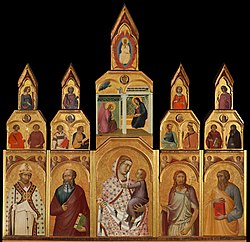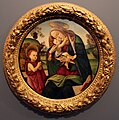Tempera: Difference between revisions
→External links: new link historic techniques |
|||
| Line 67: | Line 67: | ||
==External links== |
==External links== |
||
*[http://www.cennini21.com] Sylvana Barrett - Techniques |
|||
*[http://www.lindapaul.com/about_egg_tempera.htm About Egg Tempera] |
*[http://www.lindapaul.com/about_egg_tempera.htm About Egg Tempera] |
||
*[http://www.watercolorpainting.com/eggtempera.htm Egg Tempera Painting] |
*[http://www.watercolorpainting.com/eggtempera.htm Egg Tempera Painting] |
||
Revision as of 05:27, 20 August 2010

Tempera, also known as egg tempera, is a permanent fast drying painting medium consisting of colored pigment mixed with a water-soluble binder medium (usually a glutinous material such as egg yolk or some other size). Tempera also refers to the paintings done in this medium. Tempera paintings are very long lasting, and examples from the first centuries AD still exist. Egg tempera was a primary method of painting until after 1500 when it was superseded by the invention of oil painting. A version of tempera consisting of pigment and glue size is commonly used and referred to by some manufacturers in America as poster paint.
History
Tempera painting has been found on early Egyptians sarcophagi decorations. Many of the Fayum mummy portraits use tempera, sometimes in combination with encaustic.
Related technique has been used also in ancient and early medieval paintings found in several caves and rock-cut temples of India[1]. High quality art with the help of tempera was created in Bagh Caves between late 4th - 10th century AD and in 7th century AD in Ravan Chhaya rock shelter, Orissa[2].
The art technique was known from the classical world, where it appears to have taken over from encaustic painting[citation needed] and was the main medium used for panel painting and illuminated manuscripts in the Byzantine world and Medieval and Early renaissance Europe. Tempera painting was the primary panel painting medium for nearly every painter in the European Medieval and Early renaissance period up to 1500. For example, every surviving panel painting by Michelangelo is egg tempera.
Oil paint, which may have originated in Afghanistan between the 5th and 9th Centuries[3] and migrated westward in the Middle Ages[4] eventually superseded tempera. Oil replaced tempera as the principal medium used for creating artworks during the 15th century in Early Netherlandish painting in northern Europe. Around the year 1500, oil paint replaced tempera in Italy. In the nineteenth and twentieth centuries there were intermittent revivals of tempera technique in Western art, among the Pre-Raphaelites, Social Realists, and others. Tempera painting continues to be used in Greece and Russia where it is the required medium for Orthodox icons.
Technique
Tempera is traditionally created by hand-grinding dry powdered pigments into a binding agent or medium, such as egg, glue, honey, water, milk (in the form of casein) and a variety of plant gums.
Tempera painting starts with placing a small amount of the pigment paste onto a palette, dish or bowl and adding about an equal volume of the binder and mixing. Some pigments require slightly more binder, some require less. Distilled water is added.
Egg tempera

The most common form of classical tempera painting is "egg tempera". For this form most often only the contents of the egg yolk is used. The white of the egg and even the membrane of the yolk are discarded (the membrane of the yolk is dangled over a receptacle and punctured to drain off the liquid inside).
The paint mixture has to be constantly adjusted to maintain a balance between a "greasy" and "watery" consistency by adjusting the amount of water and yolk. As tempera dries, the artist will add more water to preserve the consistency and to balance the thickening of the yolk on contact with air.
Different preparations use the egg white or the whole egg for different effect. Other additives such as oil and wax emulsions can modify the medium. Adding oil for instance in no more than a 1:1 ratio with the egg yolk by volume will produce a water soluble medium with many of the color effects of oil paint, although it cannot be painted thickly.
Pigments
Some of the pigments used by medieval painters, such as Vermilion (made from cinnabar, a mercury ore), are highly toxic. Most artists today use modern synthetic pigments, which are less toxic but have similar color properties to the older pigments. Even so, many (if not most) modern pigments are still dangerous unless certain precautions are taken; these include keeping pigments wet in storage to avoid breathing their dust.
Application
Tempera paint dries rapidly. It is normally applied in thin, semi-opaque or transparent layers. Tempera painting allows for great precision when used with traditional techniques that require the application of numerous small brush strokes applied in a cross-hatching technique. When dry, it produces a smooth matte finish. Because it cannot be applied in thick layers as oil paints can, tempera paintings rarely have the deep color saturation that oil paintings can achieve. In this respect the colors of an unvarnished tempera painting resemble a pastel, although the color deepens if a varnish is applied. On the other hand, tempera colors do not change over time[5], whereas oil paints darken, yellow, and become transparent with age.[6]
Ground

Tempera adheres best to an absorbent ground that has a lower "oil" content than the tempera binder used[7] (the traditional rule of thumb is "fat over lean", and never the other way around).[8] The ground traditionally used is inflexible Italian gesso, and the substrate is usually rigid as well.[9] Historically wood panels were used as the substrate, and more recently un-tempered masonite and modern composite boards have been employed. Heavy paper is also used.
Tempera artists
Although tempera has been out of favor since the Late Renaissance and Baroque eras, it has been periodically rediscovered by such later artists such as William Blake, the Nazarenes, the Pre-Raphaelites, and Joseph Southall. The twentieth century saw a significant revival of tempera. European painters who worked with tempera include Giorgio de Chirico, Otto Dix, and Pyke Koch;[10] and the medium was popular with American artists such as the Regionalist Thomas Hart Benton and his student Roger Medearis; Social Realists Isabel Bishop, Reginald Marsh, and Ben Shahn; Jacob Lawrence, Paul Cadmus, Jared French, Rudolph F. Zallinger, George Tooker, Robert Vickrey, Peter Hurd, Andrew Wyeth, and science fiction artist John Schoenherr, notable as the cover artist of Dune.
Other practicing tempera artists include, Philip Aziz, Ernst Fuchs, Antonio Roybal, George Huszar, Tim Lowly, Altoon Sultan, Grégoire Michonze, Shaul Shats, Sandro Chia (e.g. Studio 1986), Vijayan Kannampilly and Alex Colville.
Gallery of tempera art
-
Guido da Siena, Church of San Regolo, Siena, Tempera and gold on panel, 1285-1295
-
Madonna and Child with saints polyptych, Duccio, Tempera and gold on wood, 1311-1318
-
Madonna by Sassetta, Cortona, Tempera on wood, 1435
-
Sandro Botticelli, Tempera on panel, 1490-1500
-
Crivelli, Tempera on wood, transferred to canvas, 1470
-
Raphael, Tempera and gold on wood, 1503-1505
-
Marianne Stokes, Melisande (Stokes), Tempera on canvas, 1895-1898
References
- ^ Ancient and medieval Indian cave paintings - Internet encyclopedia, Wondermondo, June 10, 2010
- ^ Ravan Chhaya rock shelter near Sitabinji, Wondermondo, May 23, 2010
- ^ "World's oldest oil paintings in Afghanistan", Reuters, April 22, 2008
- ^ Theophilus mentions oil media in the 12th Century
- ^ Mayer, Ralph, 1985. The Artist's Handbook of Materials and Techniques (4th ed.). New York: Viking Penguin Inc., p. 215
- ^ Mayer, 1985, p. 119
- ^ Doerner, Max, 1946. The Materials of the Artist and Their Use in Painting. New York: Harcourt, Brace and Company. p. 230.
- ^ Mayer, Ralph, 1976. The Artist's Handbook of Materials and Techniques (3rd ed.). New York: Viking Penguin Inc., pp. 165, 253.
- ^ Mayer, 1976, p. 269.
- ^ centraalmuseum.nl
Further reading
- Altoon Sultan, The Luminous Brush: Painting With Egg Tempera, Watson-Guptill Publications, New York 1999.
- Daniel V. Thompson, Jr. (translator), Cennino de Cennini, Il Libro Dell' Arte, Dover, the most well known treatise on painting and other related techniques
- Daniel V. Thompson, Jr., Materials and Techniques of Medieval Painting, Dover: explanation and expansion on Cennini's works
- Daniel V. Thompson, Jr. The Practice of Tempera Painting: Materials and Methods, Dover Publications, Inc. 1962..







